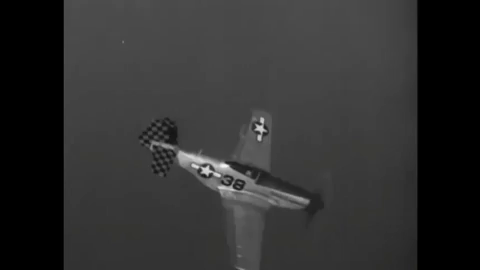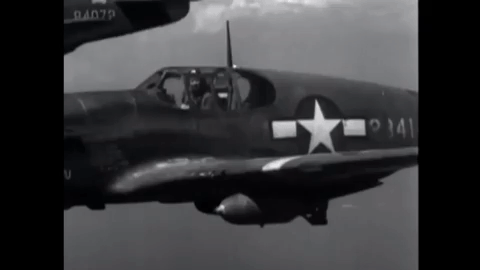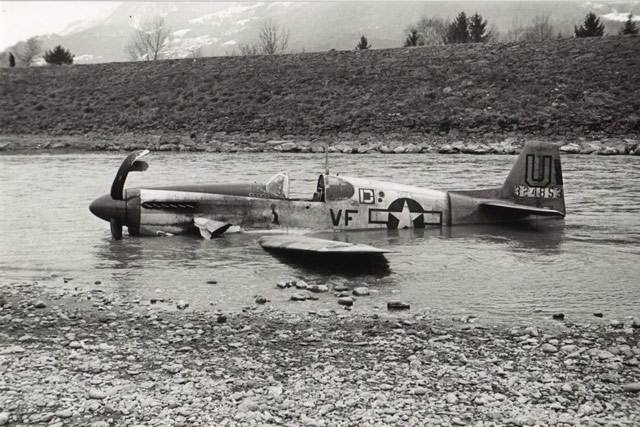The Iconic P-51 Fighter
 |
| The P-51 was a classic escort fighter. |
The United States Army Air Force (USAAF) had several excellent fighters during World War II. Among them were the Curtiss P-40 Warhawk, the P-47 Thunderbolt, and the P-38 Lightning.
The most iconic of them all, though, was the North American Aviation P-51 Mustang.
The P-51 achieved its legendary status through a sequence of unusual circumstances. It was conceived as a concept pitched to the British Purchasing Commission, in a tremendous rush for new planes during the Battle of Britain, by North American Aviation as a more modern alternative to the P-40. During this period before Lend Lease (Lend Lease became U.S. law on 11 March 1941), the British were still paying cash for their orders and not just taking whatever the Americans chose to give them.
The P-51 achieved its legendary status through a sequence of unusual circumstances. It was conceived as a concept pitched to the British Purchasing Commission, in a tremendous rush for new planes during the Battle of Britain, by North American Aviation as a more modern alternative to the P-40. During this period before Lend Lease (Lend Lease became U.S. law on 11 March 1941), the British were still paying cash for their orders and not just taking whatever the Americans chose to give them.
Taking the company on faith, the British placed their order. North American's top designer, Edgar Schmued, then quickly went to work designing and building an actual plane. Using advanced wind tunnel design techniques, he created advanced and extremely aerodynamic wings and fuselage that were very fuel-efficient. The company finished a prototype in an astonishingly short period of 102 days even though the United States was not at war and not under any particular pressure. The prototype first flew six weeks later, on 26 October 1940, during the dying days of the Battle of Britain.
The British weren't happy when they got their first versions of the P-51, designated Mark I. Its Allison V-1710 engine was fine below 15,000 feet and the plane's flight characteristics were fine. However, due to its single-stage supercharger, the engine lost its power at higher altitudes. The Luftwaffe's Bf-109 fighter, powered by a Daimler-Benz DB 601 and then 605 engine, had fuel injection that provided superior performance at higher altitudes. This was a big problem because the Luftwaffe pilots preferred the high ground anyway.
Prospects looked bleak for the P-51. It appeared it would be relegated to the decidedly unprestigious roles of tactical reconnaissance and ground-attack fighter-bomber. However, a Rolls Royce test pilot, Ronald Harker, had an inspiration. The airframe was excellent, he reasoned. Why not put a Rolls Royce Merlin engine used in the Royal Air Force's Supermarine Spitfire into the Mustang, since it did not have the Allison engine's high-altitude failings? The idea made perfect logical sense and was immediately embraced by the RAF.
The engine chosen was the Merlin 61. Unlike the Allison engine, it had a two-speed, two-stage, inter-cooled supercharger, designed by Stanley Hooker of Rolls-Royce, that gave it superior performance at higher altitudes. This change increased the Mustang's 390 mph (340 knots, 630 km/h) at ~15,000 feet (4,600 m) to around 440 mph (380 knots 710 km/h) at 28,100 feet (8,600 m). This was a dramatic difference that made the Mustang a competitor as an air superiority fighter. This version became the Mustang Mk X.
At North American Aviation, the hard decision was made to scrap the Allison engine and replace it with a US license-built Packard version of the Merlin engine. Basically, it was the same Merlin 61 engine, just made in a United States factory. Performance of this version gave a top speed of 445 mph (387 knots, 716 km/h) at 28,000 feet (8,500 m), with a service ceiling of 42,000 feet (13,000 m). This was more than sufficient to compete with the Bf 109 fighter, let alone the new Focke Wulf Fw-190, which was the Luftwaffe's top fighter at lower altitudes.
After some design changes to the Mustang to accommodate the 350-lb heavier Merlin engine led to the P-51B, the USAAF asked in July 1943 that the plane be further modified to maximize fuel capacity. The goal was to enable the Mustang to accompany bombers to the heart of the Reich. The company did some further design changes and added an additional 85 US gal (320 liter, 71 imp gal) fuel tank in the fuselage behind the pilot. This version, the P-51C, had greatly increased range. A bonus was that the P-51Bs could be converted into P-51Cs by using a kit supplied by North American Aviation.
The final and definitive version of the Mustang, the P-51D, appeared in mid-1944. It had a Packard V-1650-7 engine, a license-built version of the two-speed, two-stage-supercharged Merlin 66. The P-51D had a range of 1,650 mi (2,660 km, 1,434 nautical miles) with external tanks, allowing it to accompany bombers all the way to Berlin. While the later Spitfire versions could achieve roughly the same maximum speed as the Mustang and perhaps fly even a little faster, they were interceptor fighters, not escort fighters, and could only stay in the air for a little over an hour. The Mustangs could fly for hours and hours, lingering over the Reich and waiting for opportunities.
The enhanced performance of the P-51C and P-51D had a dramatic impact on the battle for aerial supremacy. Major General James Doolittle, the commander of the 8th Air Force and hero of the "Doolittle Raid" against Tokyo, was so satisfied with the Mustang's capabilities that he changed the rules of engagement in early 1944. Thereafter, Mustang pilots could only loosely cover the bomber stream while they hunted for Luftwaffe fighters and attacked their airfields. This had a dramatic effect on loosening the Luftwaffe's control of the skies over the Reich, let alone Allied territory.
As control of the skies shifted to the Allies, it enabled major changes in strategy. The RAF was able to return to daylight bombing in 1944 after years of night raids. This greatly increased bombing accuracy and further weakened the Luftwaffe's ability to defend the skies.
While the Luftwaffe fought back with new tactics and planes, such as the jet-engine Me 262 Swallow fighter, the P-51D fighters basically cleared the skies over the Western Front. Whereas in the past the Wehrmacht had been able to use the Luftwaffe to help its ground battles, now it had to plan attacks - such as the Battle of the Bulge - for poor weather conditions in which neither side's planes could operate. Thus, the evolution of the Mustang fighter affected both strategy and tactics to the benefit of the Allies, shifting the entire course of the war.
Reichsmarshall Hermann Goering, the head of the Luftwaffe, admitted upon his capture that, "When I saw Mustangs over Berlin, I knew the jig was up." Those fighters were P-51 Mustangs. No other fighter of World War II had as profound an impact on events as did the North American Aviation P-51 Mustang.
2021
 |
| Never forget the pilots who made the P-51 into a legend. |
The British weren't happy when they got their first versions of the P-51, designated Mark I. Its Allison V-1710 engine was fine below 15,000 feet and the plane's flight characteristics were fine. However, due to its single-stage supercharger, the engine lost its power at higher altitudes. The Luftwaffe's Bf-109 fighter, powered by a Daimler-Benz DB 601 and then 605 engine, had fuel injection that provided superior performance at higher altitudes. This was a big problem because the Luftwaffe pilots preferred the high ground anyway.
Prospects looked bleak for the P-51. It appeared it would be relegated to the decidedly unprestigious roles of tactical reconnaissance and ground-attack fighter-bomber. However, a Rolls Royce test pilot, Ronald Harker, had an inspiration. The airframe was excellent, he reasoned. Why not put a Rolls Royce Merlin engine used in the Royal Air Force's Supermarine Spitfire into the Mustang, since it did not have the Allison engine's high-altitude failings? The idea made perfect logical sense and was immediately embraced by the RAF.
The engine chosen was the Merlin 61. Unlike the Allison engine, it had a two-speed, two-stage, inter-cooled supercharger, designed by Stanley Hooker of Rolls-Royce, that gave it superior performance at higher altitudes. This change increased the Mustang's 390 mph (340 knots, 630 km/h) at ~15,000 feet (4,600 m) to around 440 mph (380 knots 710 km/h) at 28,100 feet (8,600 m). This was a dramatic difference that made the Mustang a competitor as an air superiority fighter. This version became the Mustang Mk X.
At North American Aviation, the hard decision was made to scrap the Allison engine and replace it with a US license-built Packard version of the Merlin engine. Basically, it was the same Merlin 61 engine, just made in a United States factory. Performance of this version gave a top speed of 445 mph (387 knots, 716 km/h) at 28,000 feet (8,500 m), with a service ceiling of 42,000 feet (13,000 m). This was more than sufficient to compete with the Bf 109 fighter, let alone the new Focke Wulf Fw-190, which was the Luftwaffe's top fighter at lower altitudes.
After some design changes to the Mustang to accommodate the 350-lb heavier Merlin engine led to the P-51B, the USAAF asked in July 1943 that the plane be further modified to maximize fuel capacity. The goal was to enable the Mustang to accompany bombers to the heart of the Reich. The company did some further design changes and added an additional 85 US gal (320 liter, 71 imp gal) fuel tank in the fuselage behind the pilot. This version, the P-51C, had greatly increased range. A bonus was that the P-51Bs could be converted into P-51Cs by using a kit supplied by North American Aviation.
The final and definitive version of the Mustang, the P-51D, appeared in mid-1944. It had a Packard V-1650-7 engine, a license-built version of the two-speed, two-stage-supercharged Merlin 66. The P-51D had a range of 1,650 mi (2,660 km, 1,434 nautical miles) with external tanks, allowing it to accompany bombers all the way to Berlin. While the later Spitfire versions could achieve roughly the same maximum speed as the Mustang and perhaps fly even a little faster, they were interceptor fighters, not escort fighters, and could only stay in the air for a little over an hour. The Mustangs could fly for hours and hours, lingering over the Reich and waiting for opportunities.
The enhanced performance of the P-51C and P-51D had a dramatic impact on the battle for aerial supremacy. Major General James Doolittle, the commander of the 8th Air Force and hero of the "Doolittle Raid" against Tokyo, was so satisfied with the Mustang's capabilities that he changed the rules of engagement in early 1944. Thereafter, Mustang pilots could only loosely cover the bomber stream while they hunted for Luftwaffe fighters and attacked their airfields. This had a dramatic effect on loosening the Luftwaffe's control of the skies over the Reich, let alone Allied territory.
As control of the skies shifted to the Allies, it enabled major changes in strategy. The RAF was able to return to daylight bombing in 1944 after years of night raids. This greatly increased bombing accuracy and further weakened the Luftwaffe's ability to defend the skies.
While the Luftwaffe fought back with new tactics and planes, such as the jet-engine Me 262 Swallow fighter, the P-51D fighters basically cleared the skies over the Western Front. Whereas in the past the Wehrmacht had been able to use the Luftwaffe to help its ground battles, now it had to plan attacks - such as the Battle of the Bulge - for poor weather conditions in which neither side's planes could operate. Thus, the evolution of the Mustang fighter affected both strategy and tactics to the benefit of the Allies, shifting the entire course of the war.
Reichsmarshall Hermann Goering, the head of the Luftwaffe, admitted upon his capture that, "When I saw Mustangs over Berlin, I knew the jig was up." Those fighters were P-51 Mustangs. No other fighter of World War II had as profound an impact on events as did the North American Aviation P-51 Mustang.
 |
| A P-51 shot down in Switzerland after straying across the border. |
2021
No comments:
Post a Comment